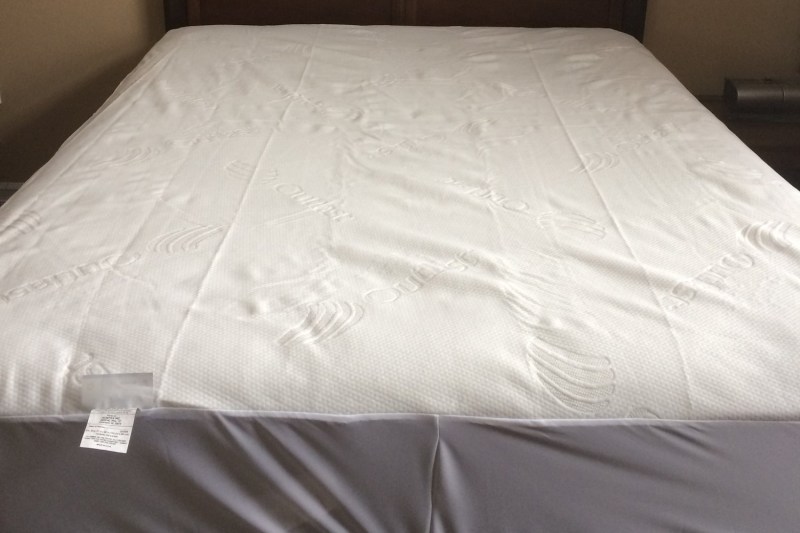Purchasing a good mattress can be a surprisingly confusing process: Should you get a firm mattress or a soft one? A hybrid mattress or memory foam mattress? Are any of those bed-in-a-box mattresses any good? And the confusing decision tree doesn’t necessarily end there; once you finally choose the best mattress, you have to decide if and how you need to accessorize it. Should you get a mattress pad or a mattress protector? Or, do you need both? Are they the same thing?
If you’re finding yourself trying to navigate these very questions, keep reading for our quick guide to the need-to-know information about mattress pads versus mattress protectors, so that you can make an informed decision and get the most out of your mattress.
Related Guides
What Is a Mattress Pad?

A mattress pad is a quilted pad that is placed on the top of the mattress under the sheets. Similar to a sheet, a mattress pad is usually fitted and relatively thin (1-2 inches). The padded portion covers the entire top surface of the mattress while the sides are thin like a sheet and only serve to anchor the mattress pad in place. Mattress pads help make the mattress more comfortable by providing a bit of extra cushioning. This is particularly relevant for older mattresses, which might have lost the plushness and give to their top layer, yet it is too soon to replace the mattress entirely. A new mattress may not need not be as worn down, but if your mattress is older and feels less comfortable than you remember it being, getting a new mattress pad can provide a feeling of rejuvenation in terms of the cushiness of your old mattress and make for a more comfortable bed without having to prematurely invest in a whole new mattress.
That said, there are other reasons to use a mattress pad. Side sleepers sometimes need additional give in the mattress to help reduce back pressure and built-up tension under bony prominences like the shoulders and hips. A firm mattress may not conform enough to the body in these cases, particularly if the top cushioning has compressed over time and exposed, or nearly exposed, the innerspring.
Additionally, a mattress pad can potentially extend the life of your mattress because it can serve as an added barrier between your body and the mattress, meaning that it can absorb some sweat, spills, and other fluids and shield the top layer of your mattress from undue friction and wear and tear. That said, mattress pads are generally not actually waterproof so they will not provide full protection against fluid infiltration into the mattress.
Read More: Best Mattresses for Side Sleepers
What Is a Mattress Protector?

As the name suggests, a mattress protector is primarily designed to protect your mattress rather than provide cushioning and comfort. It is a thin piece of waterproof fabric that covers the top and sides of a mattress to form a protective barrier around the mattress. By encapsulating the mattress in a protective shield, a mattress protector prevents sweat, body oils, liquids, spills, and bacteria from penetrating the mattress and causing any sort of mold or foul odors over time, or from slowly degrading the materials of the mattress. A mattress protector can also safeguard against a bedbug infestation. In these ways, mattress protectors help guard against potential damage to your mattress (some types of which can otherwise invalidate the warranty) and can extend the life of the mattress.
A mattress protector can also help seal in the thousands of bacteria, dust mites, and allergens inhabiting the typical mattress so that they don’t cause irritation. This can be particularly beneficial for those with bad allergies. If this is your primary interest, be sure to get a hypoallergenic mattress protector with a dust mite barrier. Similarly, some mattresses contain harmful chemicals like flame retardants, plasticizers, and other carcinogens, and a high-quality mattress protector can help contain these compounds and keep them from causing harm.
Mattress Pads Versus Mattress Protectors: Key Similarities
Mattress pads and mattress protectors are both thin coverings for your mattress that provide some degree of protection to the mattress.
Mattress Pads Versus Mattress Protectors: Key Differences

Mattress pads have 1-2 inches of quilted cushion and are primarily intended to make the mattress feel more comfortable and plush. They are particularly beneficial for older mattresses that have lost their cushioned give. They look like a fitted sheet.
Mattress protectors usually encapsulate the entire mattress to seal it in. As they are designed to protect the mattress, they are waterproof and contain no cushioning. They tend to be more expensive than mattress pads and may be somewhat noisy due to the materials used. Mattress protectors are particularly important for new mattresses because they protect against damage to the mattress—potentially protecting the warranty from invalidation—and seal in allergens and toxins.
Final Takeaway
Both mattress pads and mattress protectors serve as replaceable covers you can fit over your mattress to either increase comfort or provide protection to the mattress itself. Mattress pads, which fit like fitted sheets, are used to provide extra cushioning and comfort to a mattress, making them an affordable way to extend the life of a mattress in terms of renewing its comfort. Mattress protectors usually fully encase a mattress and protect it from body oils, liquids, and sweat, helping prevent mold growth and premature breakdown of the mattress. They are an especially good investment for new mattresses. Mattress protectors also seal in allergens, chemicals, and other irritants, reducing the potential health consequences of a mattress.




